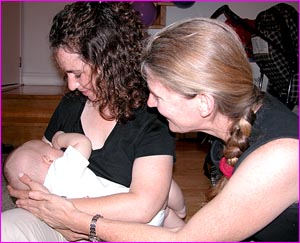First up was that of Zeny Feliciano, with an article from the Philippine Inquirer entitled "Milk Maid". Zeny is a breastfeeding coach who also conducts classes with Cher at Organics Asia. I personally have not met Zeny but I do read about her experiences working with new moms. (Update: I have received comments from several moms about negative experiences with Zeny. Please email me for details.) I did meet her trainer, Lita Nery who is also a breastfeeding coach and does lactation massages. (Edit: Per Ms. Lita Nery, she never trained Zeny.)
A few days later I read about the Breast Whisperer from New York, Freda Rosenfeld, a certified lactation consultant who has seen 2,000 moms (wow!). Like Zeny, she visits moms at home and helps them, coaches them and teaches the moms and their babies how to achieve that perfect latch. She also identifies other problems which may have led to the difficulty in breastfeeding. What I like about Ms. Rosenfeld is her credo: Rule 1, enjoy the baby. Rule 2, feed the baby.
Freda reminded me of Pat Shelley from Washington DC. Like Freda, Pat is an IBCLC counselor who was also the subject of a similar "breast whisperer" article in 2008. She runs the Breastfeeding Center for Greater Washington, a non-profit office which regularly conducts free breastfeeding classes and also does for-pay home or office one-on-one visits and consults. While pregnant with Naima, I signed up for and attended their free breastpump basics and free breastfeeding classes. The classes were about 1.5 hours and usually scheduled during lunch time. During the breast pump class, Pat Shelley even got one of the pumping moms to show how to hand-express milk!
Aside from classes, when you sign up for their emails, the Center also regularly sends helpful emails depending on your child's age e.g. meeting babies' needs for the 1st 6 months, starting solids, vitamin D and the breastfed baby, weaning. They also have photo fundraisers and maintain a shop with breastfeeding supplies at their office. They are currently working on referral book project which compiles recommendations for post partum support groups, breastfeeding friendly breast surgeons, oral-motor specialists, cranial-sacral therapists, and physicians and midwives who prescribe domperidone and oxytocin nasal spray and pharmacists that will offer them.
Locally, there are other breastfeeding support groups/resources that new moms can refer to, aside from Zeny. However, I don't think we have a group that offers comprehensive services and classes such as that of the Breastfeeding Center. It would be interesting to learn from the breast whisperers and develop similar programs and services for the Pinoy moms.
Aside from classes, when you sign up for their emails, the Center also regularly sends helpful emails depending on your child's age e.g. meeting babies' needs for the 1st 6 months, starting solids, vitamin D and the breastfed baby, weaning. They also have photo fundraisers and maintain a shop with breastfeeding supplies at their office. They are currently working on referral book project which compiles recommendations for post partum support groups, breastfeeding friendly breast surgeons, oral-motor specialists, cranial-sacral therapists, and physicians and midwives who prescribe domperidone and oxytocin nasal spray and pharmacists that will offer them.
Locally, there are other breastfeeding support groups/resources that new moms can refer to, aside from Zeny. However, I don't think we have a group that offers comprehensive services and classes such as that of the Breastfeeding Center. It would be interesting to learn from the breast whisperers and develop similar programs and services for the Pinoy moms.





